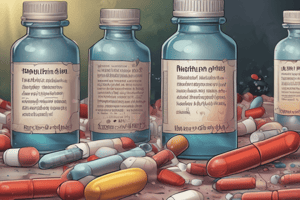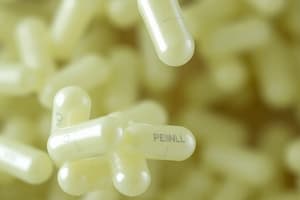Podcast
Questions and Answers
Which of the following penicillins is considered an aminopenicillin?
Which of the following penicillins is considered an aminopenicillin?
- Penicillin G
- Nafcillin
- Piperacillin
- Amoxicillin (correct)
What is the primary use of Monobactams like Aztreonam?
What is the primary use of Monobactams like Aztreonam?
- Preventing skin infections
- Targeting Gram-negative bacteria (correct)
- Treating urinary tract infections
- Fighting Gram-positive infections
Which class of antibiotics includes agents like Daptomycin and Dalbavancin?
Which class of antibiotics includes agents like Daptomycin and Dalbavancin?
- Glycopeptides
- Cephalosporins
- Carbapenems
- Lipopeptides (correct)
What distinguishes 4th generation cephalosporins from earlier generations?
What distinguishes 4th generation cephalosporins from earlier generations?
Which of the following drugs is a Glycopeptide antibiotic?
Which of the following drugs is a Glycopeptide antibiotic?
Which agent is commonly used for the treatment of Clostridium difficile infections?
Which agent is commonly used for the treatment of Clostridium difficile infections?
Which of the following is an extended-spectrum penicillin?
Which of the following is an extended-spectrum penicillin?
Which of the following drugs is a topical antibacterial agent?
Which of the following drugs is a topical antibacterial agent?
What is the role of combinations like Amoxicillin/Clavulanate?
What is the role of combinations like Amoxicillin/Clavulanate?
Which of the following is NOT a characteristic of Carbapenems?
Which of the following is NOT a characteristic of Carbapenems?
Which of the following agents belongs to the class of carbapenems?
Which of the following agents belongs to the class of carbapenems?
What is a characteristic feature of the drug class referred to as lipopeptides?
What is a characteristic feature of the drug class referred to as lipopeptides?
Which of the following drugs is NOT classified under penicillins?
Which of the following drugs is NOT classified under penicillins?
Which antibiotic is primarily used as a topical agent for skin infections?
Which antibiotic is primarily used as a topical agent for skin infections?
What is the primary mechanism of action for glycopeptides like Vancomycin?
What is the primary mechanism of action for glycopeptides like Vancomycin?
What distinguishes aminopenicillins from natural penicillins?
What distinguishes aminopenicillins from natural penicillins?
Which of the following statements about cephalosporins is FALSE?
Which of the following statements about cephalosporins is FALSE?
Which of the following agents would be classified as an extended-spectrum penicillin?
Which of the following agents would be classified as an extended-spectrum penicillin?
Which drug is known for being effective against multidrug-resistant gram-negative bacterial infections?
Which drug is known for being effective against multidrug-resistant gram-negative bacterial infections?
Which combination of drugs contains a beta-lactamase inhibitor?
Which combination of drugs contains a beta-lactamase inhibitor?
Which of the following penicillin combinations includes both Procaine and Benzathine?
Which of the following penicillin combinations includes both Procaine and Benzathine?
Which antibiotic is classified as a glycopeptide?
Which antibiotic is classified as a glycopeptide?
Which of the following agents is primarily used for urinary tract infections?
Which of the following agents is primarily used for urinary tract infections?
Which of the following statements about polypeptides is true?
Which of the following statements about polypeptides is true?
Which of the following drugs is classified under Carbapenems?
Which of the following drugs is classified under Carbapenems?
Which of the following is a 4th generation cephalosporin?
Which of the following is a 4th generation cephalosporin?
Which class of antibiotics includes Metronidazole?
Which class of antibiotics includes Metronidazole?
Which of the following antibiotics is considered effective against multidrug-resistant Gram-negative bacteria?
Which of the following antibiotics is considered effective against multidrug-resistant Gram-negative bacteria?
Which of the following agents is a topical antibacterial?
Which of the following agents is a topical antibacterial?
Which combination includes a beta-lactamase inhibitor?
Which combination includes a beta-lactamase inhibitor?
Which of the following antibiotics is classified as a 3rd generation cephalosporin?
Which of the following antibiotics is classified as a 3rd generation cephalosporin?
What is the primary characteristic of Penicillins known as anti-staphylococcal?
What is the primary characteristic of Penicillins known as anti-staphylococcal?
Which of the following drugs is a carbapenem used to treat serious infections?
Which of the following drugs is a carbapenem used to treat serious infections?
Which of the following is a feature of lipoglycopeptides?
Which of the following is a feature of lipoglycopeptides?
What distinguishes 5th generation cephalosporins from other generations?
What distinguishes 5th generation cephalosporins from other generations?
Which agent is typically included in the class of penicillins that has an extended spectrum?
Which agent is typically included in the class of penicillins that has an extended spectrum?
What is the primary function of beta-lactamase inhibitors, such as Clavulanate, when combined with beta-lactam antibiotics?
What is the primary function of beta-lactamase inhibitors, such as Clavulanate, when combined with beta-lactam antibiotics?
Which of the following is an example of a topical antibacterial agent?
Which of the following is an example of a topical antibacterial agent?
What distinguishes the Monobactam class of antibiotics?
What distinguishes the Monobactam class of antibiotics?
Which of the following agents is primarily used for the treatment of tuberculosis?
Which of the following agents is primarily used for the treatment of tuberculosis?
Flashcards are hidden until you start studying
Study Notes
Penicillins (Natural)
- Penicillin G: Available as potassium or sodium salt; forms include Benzathine (Bicillin-LA®) and Procaine formulations.
- Combination of Penicillin G Procaine and Benzathine is known as Bicillin C-R.
- Penicillin V: Also known as Phenoxymethyl Penicillin (Penicillin VK®), used for oral administration.
Penicillins (Aminopenicillins)
- Ampicillin: Marketed as Principen®.
- Ampicillin/Sulbactam: Known as Unasyn®, enhances efficacy against beta-lactamase producing bacteria.
- Amoxicillin: Available as Moxatag®, Amoxil®, Trimox®; offers better absorption than Ampicillin.
- Amoxicillin/Clavulanate: Marketed as Augmentin®, combines an antibiotic with a beta-lactamase inhibitor.
Penicillins (Anti-Staphylococcal)
- Includes Nafcillin, Oxacillin, and Dicloxacillin, effective against staphylococcal infections.
Penicillins (Extended-spectrum or Anti-pseudomonal)
- Piperacillin: Not available in some markets (NA).
- Piperacillin/Tazobactam: Known as Zosyn®, used for serious infections, especially in hospitalized patients.
- Ticarcillin/Clavulanic Acid: Marketed as Timentin®, also unavailable in some markets (NA).
Penicillins (Other)
- Sulbactam/Durlobactam: Commercially known as XacDuro®, another beta-lactamase inhibitor.
Monobactams
- Aztreonam: Distributed under the brand name Azactam®, effective against gram-negative bacteria.
Cephalosporins
- 1st Generation:
- Cefazolin: Ancef®, commonly used for surgical prophylaxis.
- Cephalexin: Retail name Keflex®, effective for skin and soft tissue infections.
- 2nd Generation:
- Cefoxitin: Known as Mefoxin®, used for anaerobic infections.
- Cefuroxime: Available as Zinacef® and Ceftin®; effective for respiratory infections.
- 3rd Generation:
- Ceftriaxone: Known as Rocephin®, broad-spectrum used in pneumonia and meningitis.
- Ceftazidime: Marketed as Fortaz®, effective against Pseudomonas aeruginosa.
- 4th Generation:
- Cefepime: Known as Maxipime®, offers activity against both gram-positive and gram-negative organisms.
- 5th Generation:
- Ceftaroline fosamil: Marketed as Teflaro®, effective against MRSA.
Carbapenems
- Notable agents include:
- Doripenem (Doribax®), Ertapenem (Invanz®), Imipenem/Cilastatin (Primaxin®), Meropenem (Merrem®).
- Combination products like Imipenem/Cilastatin/Relebactam (Recarbrio®) and Meropenem/Vaborbactam (Vabomere®).
Glycopeptides
- Vancomycin: Marketed as Vancocin®, primarily used for gram-positive infections.
Lipopeptides
- Daptomycin: Known as Cubicin®, effective against complicated skin infections.
Lipoglycopeptides
- Includes Dalbavancin (Dalvance®), Oritavancin (Orbactiv®), and Telavancin (Vibativ®) for serious gram-positive infections.
Miscellaneous Agents
- Pleuromutilin: Lefamulin (Xenleta®) used primarily for community-acquired pneumonia.
- Nitroimidazoles:
- Metronidazole (Flagyl®) and Tinidazole (Tindamax®) treat anaerobic infections.
- Other agents include Benznidazole and Secnidazole.
- Polymyxins:
- Polymyxin B Sulfate and Colistimethate (Polymyxin E) demonstrate effectiveness against gram-negative bacteria.
Rifamycins
- Rifampin (Rifadin®) is used for tuberculosis and other infections.
- Other variants include Rifaximin (Xifaxan®) and Fidaxomicin (Dificid®).
Urinary Tract Agents
- Fosfomycin (Monurol®) and Methenamine hippurate (Hipprex®) are utilized for urinary tract infections.
- Nitrofurantoin: Available as Macrodantin® and Furadantin®.
Topical Antibacterials
- Includes Bacitracin, Polymyxin B, Mafenide acetate (Sulfamylon®), and Mupirocin (Bactroban®).
- Silver Sulfadiazine (Silvadene®) used for burn wound infections.
Penicillins (Natural)
- Penicillin G: Available as potassium or sodium salt; forms include Benzathine (Bicillin-LA®) and Procaine formulations.
- Combination of Penicillin G Procaine and Benzathine is known as Bicillin C-R.
- Penicillin V: Also known as Phenoxymethyl Penicillin (Penicillin VK®), used for oral administration.
Penicillins (Aminopenicillins)
- Ampicillin: Marketed as Principen®.
- Ampicillin/Sulbactam: Known as Unasyn®, enhances efficacy against beta-lactamase producing bacteria.
- Amoxicillin: Available as Moxatag®, Amoxil®, Trimox®; offers better absorption than Ampicillin.
- Amoxicillin/Clavulanate: Marketed as Augmentin®, combines an antibiotic with a beta-lactamase inhibitor.
Penicillins (Anti-Staphylococcal)
- Includes Nafcillin, Oxacillin, and Dicloxacillin, effective against staphylococcal infections.
Penicillins (Extended-spectrum or Anti-pseudomonal)
- Piperacillin: Not available in some markets (NA).
- Piperacillin/Tazobactam: Known as Zosyn®, used for serious infections, especially in hospitalized patients.
- Ticarcillin/Clavulanic Acid: Marketed as Timentin®, also unavailable in some markets (NA).
Penicillins (Other)
- Sulbactam/Durlobactam: Commercially known as XacDuro®, another beta-lactamase inhibitor.
Monobactams
- Aztreonam: Distributed under the brand name Azactam®, effective against gram-negative bacteria.
Cephalosporins
- 1st Generation:
- Cefazolin: Ancef®, commonly used for surgical prophylaxis.
- Cephalexin: Retail name Keflex®, effective for skin and soft tissue infections.
- 2nd Generation:
- Cefoxitin: Known as Mefoxin®, used for anaerobic infections.
- Cefuroxime: Available as Zinacef® and Ceftin®; effective for respiratory infections.
- 3rd Generation:
- Ceftriaxone: Known as Rocephin®, broad-spectrum used in pneumonia and meningitis.
- Ceftazidime: Marketed as Fortaz®, effective against Pseudomonas aeruginosa.
- 4th Generation:
- Cefepime: Known as Maxipime®, offers activity against both gram-positive and gram-negative organisms.
- 5th Generation:
- Ceftaroline fosamil: Marketed as Teflaro®, effective against MRSA.
Carbapenems
- Notable agents include:
- Doripenem (Doribax®), Ertapenem (Invanz®), Imipenem/Cilastatin (Primaxin®), Meropenem (Merrem®).
- Combination products like Imipenem/Cilastatin/Relebactam (Recarbrio®) and Meropenem/Vaborbactam (Vabomere®).
Glycopeptides
- Vancomycin: Marketed as Vancocin®, primarily used for gram-positive infections.
Lipopeptides
- Daptomycin: Known as Cubicin®, effective against complicated skin infections.
Lipoglycopeptides
- Includes Dalbavancin (Dalvance®), Oritavancin (Orbactiv®), and Telavancin (Vibativ®) for serious gram-positive infections.
Miscellaneous Agents
- Pleuromutilin: Lefamulin (Xenleta®) used primarily for community-acquired pneumonia.
- Nitroimidazoles:
- Metronidazole (Flagyl®) and Tinidazole (Tindamax®) treat anaerobic infections.
- Other agents include Benznidazole and Secnidazole.
- Polymyxins:
- Polymyxin B Sulfate and Colistimethate (Polymyxin E) demonstrate effectiveness against gram-negative bacteria.
Rifamycins
- Rifampin (Rifadin®) is used for tuberculosis and other infections.
- Other variants include Rifaximin (Xifaxan®) and Fidaxomicin (Dificid®).
Urinary Tract Agents
- Fosfomycin (Monurol®) and Methenamine hippurate (Hipprex®) are utilized for urinary tract infections.
- Nitrofurantoin: Available as Macrodantin® and Furadantin®.
Topical Antibacterials
- Includes Bacitracin, Polymyxin B, Mafenide acetate (Sulfamylon®), and Mupirocin (Bactroban®).
- Silver Sulfadiazine (Silvadene®) used for burn wound infections.
Penicillins (Natural)
- Penicillin G: Available as potassium or sodium salt; forms include Benzathine (Bicillin-LA®) and Procaine formulations.
- Combination of Penicillin G Procaine and Benzathine is known as Bicillin C-R.
- Penicillin V: Also known as Phenoxymethyl Penicillin (Penicillin VK®), used for oral administration.
Penicillins (Aminopenicillins)
- Ampicillin: Marketed as Principen®.
- Ampicillin/Sulbactam: Known as Unasyn®, enhances efficacy against beta-lactamase producing bacteria.
- Amoxicillin: Available as Moxatag®, Amoxil®, Trimox®; offers better absorption than Ampicillin.
- Amoxicillin/Clavulanate: Marketed as Augmentin®, combines an antibiotic with a beta-lactamase inhibitor.
Penicillins (Anti-Staphylococcal)
- Includes Nafcillin, Oxacillin, and Dicloxacillin, effective against staphylococcal infections.
Penicillins (Extended-spectrum or Anti-pseudomonal)
- Piperacillin: Not available in some markets (NA).
- Piperacillin/Tazobactam: Known as Zosyn®, used for serious infections, especially in hospitalized patients.
- Ticarcillin/Clavulanic Acid: Marketed as Timentin®, also unavailable in some markets (NA).
Penicillins (Other)
- Sulbactam/Durlobactam: Commercially known as XacDuro®, another beta-lactamase inhibitor.
Monobactams
- Aztreonam: Distributed under the brand name Azactam®, effective against gram-negative bacteria.
Cephalosporins
- 1st Generation:
- Cefazolin: Ancef®, commonly used for surgical prophylaxis.
- Cephalexin: Retail name Keflex®, effective for skin and soft tissue infections.
- 2nd Generation:
- Cefoxitin: Known as Mefoxin®, used for anaerobic infections.
- Cefuroxime: Available as Zinacef® and Ceftin®; effective for respiratory infections.
- 3rd Generation:
- Ceftriaxone: Known as Rocephin®, broad-spectrum used in pneumonia and meningitis.
- Ceftazidime: Marketed as Fortaz®, effective against Pseudomonas aeruginosa.
- 4th Generation:
- Cefepime: Known as Maxipime®, offers activity against both gram-positive and gram-negative organisms.
- 5th Generation:
- Ceftaroline fosamil: Marketed as Teflaro®, effective against MRSA.
Carbapenems
- Notable agents include:
- Doripenem (Doribax®), Ertapenem (Invanz®), Imipenem/Cilastatin (Primaxin®), Meropenem (Merrem®).
- Combination products like Imipenem/Cilastatin/Relebactam (Recarbrio®) and Meropenem/Vaborbactam (Vabomere®).
Glycopeptides
- Vancomycin: Marketed as Vancocin®, primarily used for gram-positive infections.
Lipopeptides
- Daptomycin: Known as Cubicin®, effective against complicated skin infections.
Lipoglycopeptides
- Includes Dalbavancin (Dalvance®), Oritavancin (Orbactiv®), and Telavancin (Vibativ®) for serious gram-positive infections.
Miscellaneous Agents
- Pleuromutilin: Lefamulin (Xenleta®) used primarily for community-acquired pneumonia.
- Nitroimidazoles:
- Metronidazole (Flagyl®) and Tinidazole (Tindamax®) treat anaerobic infections.
- Other agents include Benznidazole and Secnidazole.
- Polymyxins:
- Polymyxin B Sulfate and Colistimethate (Polymyxin E) demonstrate effectiveness against gram-negative bacteria.
Rifamycins
- Rifampin (Rifadin®) is used for tuberculosis and other infections.
- Other variants include Rifaximin (Xifaxan®) and Fidaxomicin (Dificid®).
Urinary Tract Agents
- Fosfomycin (Monurol®) and Methenamine hippurate (Hipprex®) are utilized for urinary tract infections.
- Nitrofurantoin: Available as Macrodantin® and Furadantin®.
Topical Antibacterials
- Includes Bacitracin, Polymyxin B, Mafenide acetate (Sulfamylon®), and Mupirocin (Bactroban®).
- Silver Sulfadiazine (Silvadene®) used for burn wound infections.
Penicillins (Natural)
- Penicillin G: Available as potassium or sodium salt; forms include Benzathine (Bicillin-LA®) and Procaine formulations.
- Combination of Penicillin G Procaine and Benzathine is known as Bicillin C-R.
- Penicillin V: Also known as Phenoxymethyl Penicillin (Penicillin VK®), used for oral administration.
Penicillins (Aminopenicillins)
- Ampicillin: Marketed as Principen®.
- Ampicillin/Sulbactam: Known as Unasyn®, enhances efficacy against beta-lactamase producing bacteria.
- Amoxicillin: Available as Moxatag®, Amoxil®, Trimox®; offers better absorption than Ampicillin.
- Amoxicillin/Clavulanate: Marketed as Augmentin®, combines an antibiotic with a beta-lactamase inhibitor.
Penicillins (Anti-Staphylococcal)
- Includes Nafcillin, Oxacillin, and Dicloxacillin, effective against staphylococcal infections.
Penicillins (Extended-spectrum or Anti-pseudomonal)
- Piperacillin: Not available in some markets (NA).
- Piperacillin/Tazobactam: Known as Zosyn®, used for serious infections, especially in hospitalized patients.
- Ticarcillin/Clavulanic Acid: Marketed as Timentin®, also unavailable in some markets (NA).
Penicillins (Other)
- Sulbactam/Durlobactam: Commercially known as XacDuro®, another beta-lactamase inhibitor.
Monobactams
- Aztreonam: Distributed under the brand name Azactam®, effective against gram-negative bacteria.
Cephalosporins
- 1st Generation:
- Cefazolin: Ancef®, commonly used for surgical prophylaxis.
- Cephalexin: Retail name Keflex®, effective for skin and soft tissue infections.
- 2nd Generation:
- Cefoxitin: Known as Mefoxin®, used for anaerobic infections.
- Cefuroxime: Available as Zinacef® and Ceftin®; effective for respiratory infections.
- 3rd Generation:
- Ceftriaxone: Known as Rocephin®, broad-spectrum used in pneumonia and meningitis.
- Ceftazidime: Marketed as Fortaz®, effective against Pseudomonas aeruginosa.
- 4th Generation:
- Cefepime: Known as Maxipime®, offers activity against both gram-positive and gram-negative organisms.
- 5th Generation:
- Ceftaroline fosamil: Marketed as Teflaro®, effective against MRSA.
Carbapenems
- Notable agents include:
- Doripenem (Doribax®), Ertapenem (Invanz®), Imipenem/Cilastatin (Primaxin®), Meropenem (Merrem®).
- Combination products like Imipenem/Cilastatin/Relebactam (Recarbrio®) and Meropenem/Vaborbactam (Vabomere®).
Glycopeptides
- Vancomycin: Marketed as Vancocin®, primarily used for gram-positive infections.
Lipopeptides
- Daptomycin: Known as Cubicin®, effective against complicated skin infections.
Lipoglycopeptides
- Includes Dalbavancin (Dalvance®), Oritavancin (Orbactiv®), and Telavancin (Vibativ®) for serious gram-positive infections.
Miscellaneous Agents
- Pleuromutilin: Lefamulin (Xenleta®) used primarily for community-acquired pneumonia.
- Nitroimidazoles:
- Metronidazole (Flagyl®) and Tinidazole (Tindamax®) treat anaerobic infections.
- Other agents include Benznidazole and Secnidazole.
- Polymyxins:
- Polymyxin B Sulfate and Colistimethate (Polymyxin E) demonstrate effectiveness against gram-negative bacteria.
Rifamycins
- Rifampin (Rifadin®) is used for tuberculosis and other infections.
- Other variants include Rifaximin (Xifaxan®) and Fidaxomicin (Dificid®).
Urinary Tract Agents
- Fosfomycin (Monurol®) and Methenamine hippurate (Hipprex®) are utilized for urinary tract infections.
- Nitrofurantoin: Available as Macrodantin® and Furadantin®.
Topical Antibacterials
- Includes Bacitracin, Polymyxin B, Mafenide acetate (Sulfamylon®), and Mupirocin (Bactroban®).
- Silver Sulfadiazine (Silvadene®) used for burn wound infections.
Studying That Suits You
Use AI to generate personalized quizzes and flashcards to suit your learning preferences.



